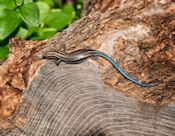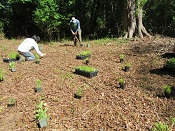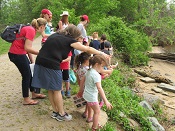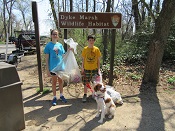
Studying Skinks in Dyke Marsh

Dyke Marsh visitors have had some good skink sightings this spring 2018. A skink is a type of lizard, typically shiny and with short or no limbs. Most skinks have tapering tails that they can shed if predators grab them and they usually can regenerate the lost part of the tail. Skinks move quickly.
Virginia has nine native lizard species, according to Alonso Abugattas, Arlington County Natural Resources Manager. Six of these species are likely in the Washington, D.C., region. “All lizards native to Virginia in the genus Plestiodon have bright blue tails as juveniles/subadults,” according to the Virginia Herpetological Society’s website.
Volunteers Restore Habitat in Dyke Marsh

On May 9, 2018, 20 dedicated volunteers and National Park Service (NPS) staffers planted around 1,500 native trees and plants on .65 acres on the west side of the Haul Road trail in Dyke Marsh. Among others, the group planted spicebush and winterberry; trees included sycamore, tulip tree, cottonwood, maples and black gum; "phorbs" included wing stem, pyeweed, tick-trefoil and moonflower vine plus grasses such as deer-tongue, Virginia rye and riverside rye.
Volunteers Test Water Quality

Determining the habitat quality of a stream flowing into Dyke Marsh from the west was the quest on May 5, 2018, when FODM volunteers conducted some biological testing of the stream flowing through Mount Vernon District Park. FODMers partnered with the Westgrove Dog Park PACK organization and led by Dan Schwartz, Northern Virginia Soil and Water Conservation District, took 20 samples from the stream within a 300-foot span, with the goal of identifying 100 living invertebrates. The group found 55 invertebrates, fewer than the desired 100. Forty of the 55 were scuds, considered to be impairment tolerant organisms.
St. Luke's Preschoolers Visit

On May 4, 2018, 30 very curious youngsters from St. Luke’s Episcopal Church Preschool visited the Dyke Marsh Wildlife Preserve. Their teacher, Jennifer Gough, prepared a scavenger hunt guide for them to use in spotting plants, animals, rocks and other “finds.”
Raptors Delight 250

Around 250 raptor fans admired beautiful birds of prey at FODM’s annual Raptor Rapture on April 21, 2018, a beautiful, sunny day in Belle Haven Park. Raptor Conservancy of Virginia experts brought an Eastern screech owl (Megascops asio), a red-tailed hawk (Buteo jamaicensis), a red-shouldered hawk (Buteo lineatus), an American kestrel (Falco sparverius) and a merlin (Falco columbarius), all “rescue birds.”
80 People Tackle Trash

With clear blue skies, a bright sun and a gentle breeze, 80 eager volunteers cleaned up trash along the Dyke Marsh and Belle Haven Park shoreline on April 14, 2018, for three hours at low tide. Many youngsters got school service credit. Everyone got exercise and a great feeling of accomplishment as the bags piled up.
Marsh Wrens, Charming Birds

“Marsh wrens are special, very charming birds,” Dr. Sarah Luttrell told the Friends of Dyke Marsh on February 25, 2018. Her presentation focused on how comparing multiple traits, including plumage color, size, shape, vocal behavior and genetics, reveals a pattern of evolution. “Genetic variations are very high within a marsh,” she said.
Bald Eagles Make Dyke Marsh their Home

As of early February 2018, three bald eagle pairs have active nests in the Dyke Marsh Wildlife Preserve. Observers have seen eagles taking sticks to nests, pairs perched, females incubating eggs and a male taking prey to a female on the nest.
Bald eagles lay two to three eggs in late winter and females incubate the eggs for five to six weeks. Between May and July, chicks fledge at 10 to 12 weeks of age. Nest construction, breeding, nesting and eaglet hatching do not always succeed.
Mammals Stand Out on an Icy Dyke Marsh

The January 2018 cold snap and days of subfreezing temperatures brought out winter’s beauty in Dyke Marsh. Particularly stunning against the icy white background was a red fox (Vulpes Vulpes), photographed by Ed Eder on January 2 off the boardwalk. The fox was prying a piece of dead fish embedded in the ice as another fox called. Eventually, the vocalizing fox joined the foraging fox.
Wintering Waterfowl

Waterfowl numbers in Dyke Marsh, Hunting Creek and along the Potomac River multiply in the winter and many people love to study and identify them. Waterfowl are ducks, geese and swans, birds that require water bodies or aquatic habitats to survive. These birds have waterproof feathers, webbed feet and broad bills.
SAV, Important to the River’s Health

Submerged aquatic vegetation (SAV), native and non-native, is increasing in the Potomac River and helps improve water quality, reported the Interstate Commission on the Potomac River Basin (ICPRB), citing the September 13, 2017, presentation to the Friends of Dyke Marsh by Dr. Nancy Rybicki, U.S. Geological Survey (see below).
Hunting Creek, Its Ecology and Health

Dr. Kim de Mutsert, Assistant Professor, George Mason University (GMU), gave a presentation to the Friends of Dyke Marsh, the Potomac Riverkeeper and the Northern Virginia Conservation Trust on November 15, 2017, examining the health of Hunting Creek, a tributary of the Potomac River just north of Dyke Marsh. This stream receives treated wastewater from the Alexandria Renew Enterprises wastewater treatment plant and untreated stormwater runoff. Since 2013, Alexandria Renew has funded GMU’s Potomac Environmental Research and Education Center to monitor water quality and the biological communities of Hunting Creek.


AlbertHerring-b4cc6b5cfb.jpg)



 Friends of Dyke Marsh, Inc. is a non-profit 501(c)(3) organization.
Friends of Dyke Marsh, Inc. is a non-profit 501(c)(3) organization.